
Discover the Brandywine floodplain on a walk that takes you through several habitats
View an interactive map here
[Please note: there is currently limited access to the River Trail due to construction activity near the Museum building. We apologize for the inconvenience while we complete this disruptive, but vital work on our campus.]
The river trail begins at the corner of the parking lot near the Museum on the river side. The walk goes from this starting point to the meadow across from the John Chads House. The distance is approximately one mile roundtrip, or 20 to 30 minutes walking at an average pace. Keep an eye out for these natural and man-made features on the trail:
Alluvial Forest

The native trees, shrubs, and plants found here grow in stratified soils formed by the silts, sands and gravels deposited by floodwaters. (You may also see evidence of 19th-century, man-made fill such as glass, foundry dust and other debris.) Periodic flooding, ice flows and extended periods of wet soil create a difficult growing environment which only certain native species can tolerate.
Trees in this floodplain forest include silver maple (Acer saccharinum), swamp white oak (Quercus bicolor), sycamore (Platanus occidentalis), black walnut (Juglans nigra), green ash (Fraxinus pennsylvanica), and box elder (Acer negundo). Understory trees and shrubs include flowering dogwood (Cornus florida), arrowwood (Viburnum dentatum), American bladdernut (Staphylea trifolia) and spicebush (Lindera benzoin).
Native wildlife species—including bald eagles, great blue herons, great egrets, northern water snakes, and common musk turtles—rely on the stream and surrounding forest for food and cover. In addition, many native wildflowers grow in the cool, moist soils of the floodplain forest floor.
This habitat helps to maintain stream water quality and a healthy stream ecosystem through its ability to prevent erosion, filter out contaminants from storm runoff, regulate water temperatures with shade, and provide food.
Mill Dam
Just beyond the Route 1 bridge on the left is a 19th-century stone mill dam used to channel water for Hoffmann’s Mill, built as a grist mill in 1864 and operated until 1941. The mill is now the Brandywine River Museum of Art building. Parts of the original mill race still exist beneath the bridge, to the far right of the trail.
Power Line Right-of-Way
Beyond the bridge the vegetation becomes more open and herbaceous. Trees growing too close to the overhead power lines are periodically trimmed or cleared by the electric company, which manages this area as a transmission line right-of-way. Young box elders are the dominant tree species here. To the left, the alluvial forest continues in a narrow strip along the banks of the Brandywine.
Wetland (follow the boardwalk)
The trail now bends to the right and heads east along a boardwalk. Known as a swamp or marsh, this wetland area is characterized by a diverse mix of trees, shrubs, wetland plants, sedges, and rushes growing on floodplain soils.
Trees include black willow (Salix nigra), silver maple (Acer saccharinum), sycamore (Platanus occidentalis), red maple (Acer rubrum), and pin oak (Quercus palustris). Wetland shrubs such as arrowwood (Viburnum dentatum), silky dogwood (Cornus amomum), and spicebush (Lindera benzoin) are common. Smaller herbaceous plants include a wide range of sedges and rushes, along with broad-leaved arrowhead, skunk cabbage and cattails.
The observation platform provides a view of this rich wildlife habitat, frequented by Carolina wrens, wood ducks, black ducks, great blue herons, and osprey. Green frogs, spring peepers and snapping turtles are also plentiful.
Most of the water in the marsh comes from road runoff and ground water seepage. The marsh is gradually filling in, as floodwaters consistently deposit their loads of silt and sediment from upstream. One day, it may become a meadow.
Floodplain Meadow
Beyond the platform, the boardwalk ends in a floodplain meadow habitat of native and introduced grasses and wildflowers. The meadow is maintained by scheduled mowing to interrupt succession, the natural process by which native trees and shrubs gradually reestablish a forest. The more colorful wildflowers include New York ironweed (Vernonia noveboracensis), Joe-Pye weed (Eupatorium fistulosum), swamp milkweed (Asclepias incarnata), various types of goldenrod (Solidago spp.) and aster (Symphyotrichum spp.).
Cross the meadow to reach the Chadds Ford Historical Society Visitors’ Center and the John Chads House.
Visit RecreateResponsibly.org for important guidelines on how to best protect yourself, others and the outdoors while enjoying the Brandywine's preserves and our region's parks, trails, and beaches.